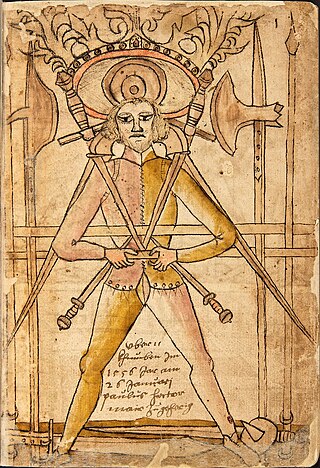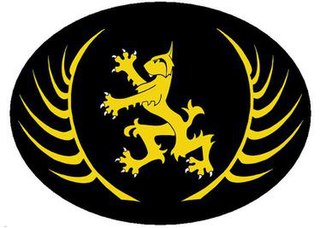Related Research Articles

Fencing is a combat sport that features sword fighting. The three disciplines of modern fencing are the foil, the épée, and the sabre ; each discipline uses a different kind of blade, which shares the same name, and employs its own rules. Most competitive fencers specialise in one discipline. The modern sport gained prominence near the end of the 19th century and is based on the traditional skill set of swordsmanship. The Italian school altered the historical European martial art of classical fencing, and the French school later refined that system. Scoring points in a fencing competition is done by making contact with an opponent.

A rapier or espada ropera is a type of sword used in Renaissance Spain to designate a sword with a straight, slender and sharply pointed two-edged long blade wielded in one hand. It was widely popular in Western Europe throughout the 16th and 17th centuries as a symbol of nobility or gentleman status.

A longsword is a type of European sword characterized as having a cruciform hilt with a grip for primarily two-handed use, a straight double-edged blade of around 80 to 110 cm, and weighing approximately 1 to 1.5 kg.

Swordsmanship or sword fighting refers to the skills and techniques used in combat and training with any type of sword. The term is modern, and as such was mainly used to refer to smallsword fencing, but by extension it can also be applied to any martial art involving the use of a sword. The formation of the English word "swordsman" is parallel to the Latin word gladiator, a term for the professional fighters who fought against each other and a variety of other foes for the entertainment of spectators in the Roman Empire. The word gladiator itself comes from the Latin word gladius, which is a type of sword.

Historical European martial arts (HEMA) are martial arts of European origin, particularly using arts formerly practised, but having since died out or evolved into very different forms.
Martial arts manuals are instructions, with or without illustrations, specifically designed to be learnt from a book. Many books detailing specific techniques of martial arts are often erroneously called manuals but were written as treatises.
Classical fencing is the style of fencing as it existed during the 19th and early 20th centuries. According to the 19th-century fencing master Louis Rondelle,
A classical fencer is supposed to be one who observes a fine position, whose attacks are fully developed, whose hits are marvelously accurate, his parries firm, and his ripostes executed with precision. One must not forget that this regularity is not possible unless the adversary is a party to it. It is a conventional bout, which consists of parries, attacks, and returns, all rhyming together.

The term Italian school of swordsmanship is used to describe the Italian style of fencing and edged-weapon combat from the time of the first extant Italian swordsmanship treatise (1409) to the days of classical fencing.
Achille Marozzo (1484–1553) was an Italian fencing master, one of the most important teachers in the Dardi or Bolognese tradition.
Fredrico Fabio Ghisliero was an Italian fencer and soldier who wrote his text Regole di molte cavagliereschi essercitii in 1587.
Bolognese Swordsmanship, also sometimes known as the Dardi school, is a tradition within the Italian school of swordsmanship which is based on the surviving fencing treatises published by several 16th century fencing masters of Bologna, As early as the 14th century several fencing masters were living and teaching in the city: a maestro Rosolino in 1338, a maestro Nerio in 1354, and a maestro Francesco in 1385.

Alfred Hutton FSA was a British Army officer, antiquarian and writer. Serving during the Victorian era in the 1st King's Dragoon Guards, he played a major role in the revival of historical fencing in England, together with fellow fencers Egerton Castle, Ernest Stenson-Cooke, Sir Frederick Pollock and Walter Herries Pollock.
The oldest surviving manual on western swordsmanship dates back to the 14th century, although historical references date fencing schools back to the 12th century.
The Chicago Swordplay Guild is a modern school of swordsmanship and Western martial arts, and non-profit organization based in Chicago, Illinois, United States. It provides organized instruction in the study and practice of historical European swordplay, with a principal focus on the Italian school of swordsmanship and other martial arts of the 14th–17th centuries. Co-founded in 1999 by Gregory Mele and Mark Rector, the Chicago Swordplay Guild seeks to be consistent with the methodology of the ancient European fencing schools by combining scholarship and research into the teachings of the historical Masters, with the practical knowledge gained through solo and partnered drilling and fencing. Since techniques are taught in reference to how effective they would be in a real encounter, the Guild practices with an absolute emphasis on safety, control, competence, and skill at arms.
Nova Scrimia is an Italian organisation which promotes the teaching of the Italian school of swordsmanship, of stick fencing, of short range fencing (dagger) and of unarmed fencing from the documented period that goes from the 15th century to the 20th century. Nova Scrimia is currently represented in Italy and other European countries, in USA and in Mexico.
Italian martial arts include all those unarmed and armed fighting arts popular in Italy between the Bronze age until the 19th century AD. It involved the usage of weapons. Each weapon is the product of a specific historical era. The swords used in Italian martial arts range from the Bronze daggers of the Nuragic times to the gladius of the Roman legionaries to swords which were developed during the renaissance, the baroque era and later. Short blades range from medieval daggers to the liccasapuni Sicilian duelling knife.

Schola Gladiatoria (SG) is a historical European martial arts (HEMA) group based in Ealing, west London, Great Britain, founded in 2001 and led by Matt Easton. It provides organized instruction in the serious study and practice of historical European swordplay. Schola seeks to be consistent with the methodology of the ancient European fencing schools by combining scholarship and research into the teachings of the historical masters, with the practical knowledge gained through solo and partnered drilling, and free play (sparring).
Girolamo Cavalcabo was a Bolognese fencing master, teaching in Rome and later Paris in the late sixteenth and early seventeenth centuries.
The practice of Historical European Martial Arts (HEMA) first started in Australia in the late 19th century before largely dying out. There was then a revival of interest in the late 20th century to the current day. The practice of HEMA in Australia has grown to be a popular activity, with clubs all in capital cities, and the larger cities in Australia, Sydney and Melbourne, each have a number of clubs teaching various styles.

Luigi Barbasetti was an Italian fencing master and reformer. His teacher was fencing master Giuseppe Radaelli, who trained him to be a "military master of arms". Barbasetti's second teacher was fencing master Masaniello Parise from the Masters School in Rome. After training he taught at the Masters School in Rome. He became a fencing master of Triest before he was called to Vienna. In the fall of 1894 Barbasetti arrived in Vienna. Under the patronage of Archduke Franz Salvator, he played a leading role in the reform of the sport of fencing in Vienna in 1895 by making the modern Italian fencing method accessible to the German-speaking area. In 1895 he founded the fencing school "Union Fechtklub Wien" that still exists today. He developed a Hungarian style of saber technique, which dominated saber fencing for the first half of the twentieth century and trained the Hungarian master József Keresztessy also called “father of Hungarian sabre fencing.” In 1915 Barbasetti had to leave Germany because Italy took part in the war against Germany. He returned to Italy until he moved to Paris in 1921, where he taught at the Automobile Club and the Golfers Club. He returned again to Italy in 1943 and died in Verona on March 31, 1948.
References
- ↑ Gaugler, William M. (1998). The history of fencing : foundations of modern European swordplay (1st ed.). Bangor, Maine: Laureate Press. p. 194. ISBN 1884528163. OCLC 39752750.